The chest-supported row is similar to the bent-over row and helps you work most of the back muscles.
It is one of the most widely used compound exercises, working many muscles in the upper body and improving strength and endurance.
As the name implies, it is a type of row in which your chest is supported on a bench.
Unlike other ways of rowing, like the bent-over row, this one doesn’t let you cheat and doesn’t hurt your lower back.
This row is much more effective for targeting the back muscles because it doesn’t require other muscles to stay stable throughout the movement. This exercise can target different muscles depending on how your arm is positioned and how you are holding the weight.
There are several variations of the chest-supported rows that you can do with dumbbell, barbell, cable, or machine.
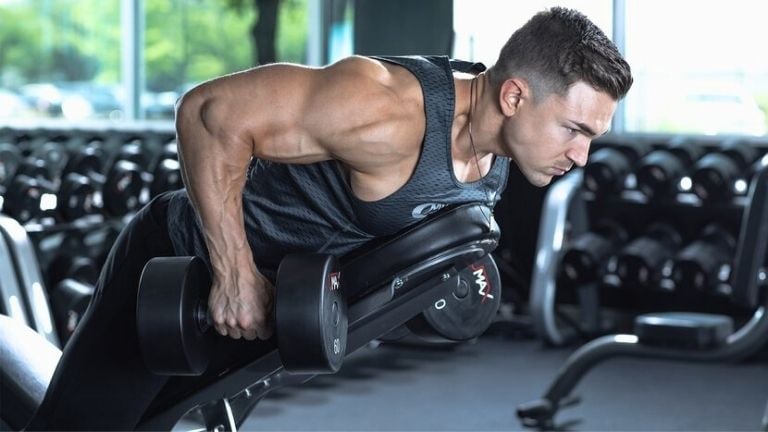
- Variations Of Chest Supported Row
- Chest-Supported Row Variations Using Equipment
- Chest Supported Row – Grip Positions
- Chest Supported Row- Grip Width
- Chest Supported Row Muscles Worked
- Dumbbell Chest Supported Row
- 1. Chest-Supported Dumbbell Row
- 2. Chest Supported Neutral Grip Dumbbell Row
- Barbell Chest Supported Row
- 1. Barbell Chest Supported Row
- 2. Chest Supported Reverse Grip Barbell Row
- 3. Barbell Lying Row (Flat Bench Row)
- Chest Supported Row With Cable
- 1. Chest Supported Cable Row
- 2. Underhand Grip Chest Supported Cable Row
- Machine Chest Supported Row
- 1. Chest Supported Machine Row
- 2. Chest Supported T-Bar Row
- 3. Chest Supported Reverse Grip T-Bar Row
- FAQs
- is chest supported row a compound movement
- Why are chest-supported rows harder
- Chest supported row vs. bent over row
- Chest-supported row vs Cable seated row
- Does chest support row work biceps?
- References
Variations Of Chest Supported Row
You can do the chest-supported row with different grips like overhand, reverse, and neutral grips and hand positions like wide and close. You can also use different gym equipment like dumbbells, barbells, cables, or machines.
Chest-Supported Row Variations Using Equipment
We created the supported row exercises for many sections, such as:
- Chest Supported Row With Dumbbells.
- Barbell Chest Supported Row
- Chest Supported Row with Cables.
- Machine Chest Supported Row.
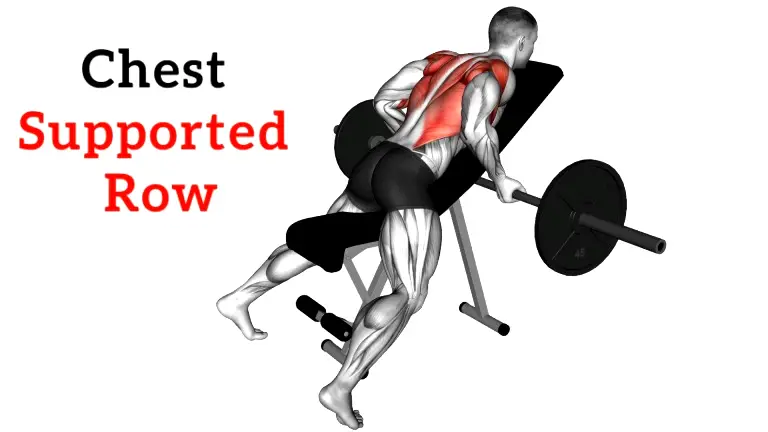
Chest Supported Row – Grip Positions
Here are some ways to alter your supported row to hit different muscles.
1. Overhand (Pronated) Grip
The overhand grip will target the upper back more. Because the elbows will push out from the body, the upper back and delts will receive increased activation.
2. Underhand (Supinated) Grip
On the other hand, an underhand grip will force the elbows to stay close to the body. This will generally cause greater activation of the middle and lower traps. You will get more bicep activation because of elbow extension.
3. Neutral Grip
A neutral grip can be used with various elbow angles. However, its main benefit is that it takes stress off the elbow. Because of this, people who suffer from elbow pain will love using a neutral grip.
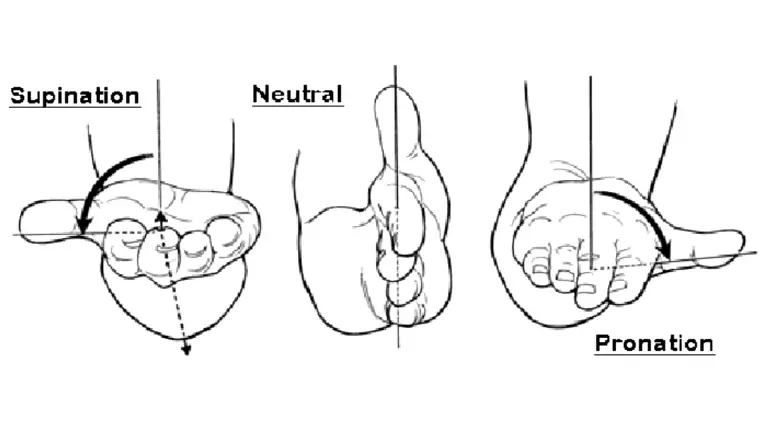
Chest Supported Row- Grip Width
1. Narrow Grip
Using a narrow grip usually drops your elbows, which causes you to pull lower. This will hit your lats, middle, and lower traps more. Additionally, the biceps receive a greater workout with a higher range of motion.
2. Wide Grip
A wide grip will force you to use an overhand grip and force your elbows out. This will enhance the emphasis on the rhomboids and rear deltoid.
Chest Supported Row Muscles Worked
The chest-supported row is a compound exercise, which means that it activates various muscle groups.
- Primarily Muscles Worked: Latissimus dorsi, Rhomboids and Trapezius muscle groups.
- Secondary Muscles Worked: Biceps, brachialis, rear deltoid, Brachioradialis, Teres Major and Minor.
- Stabilizing Muscles Worked: Erector Spinae, Core muscles (including Rectus Abdominis, Transverse Abdominis), forearms, Rotator Cuff muscles
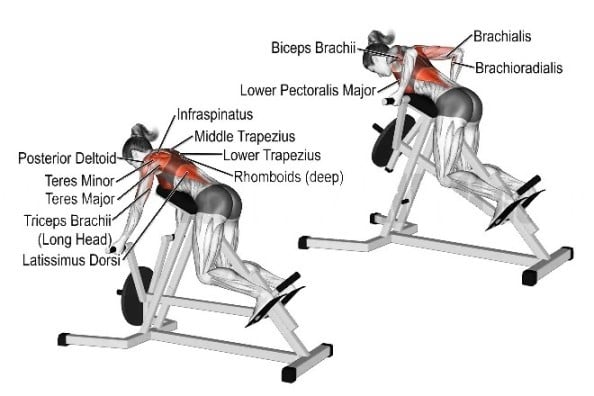
Dumbbell Chest Supported Row
There are many advantages of doing chest-supported row exercises using dumbbells, such as:
- Dumbbells require more balance than barbells or machines, which can lead to greater muscle fibre recruitment.
- The dumbbell provides unilateral training and improves muscular imbalances.
- It provides a greater level of variety, which helps prevent physical and mental burnout.
- Dumbbell exercise variations allow for a greater range of movement (ROM).
1. Chest-Supported Dumbbell Row
The chest-supported dumbbell row, also called the incline dumbbell row, is an ideal row variation for improving form, preventing mid-row rocking, reducing the risk of injury, and isolating the muscles.
The muscles used for a dumbbell-supported row may change slightly based on your trained range of motion and technique.
To increase the variety of your chest-supported dumbbell row, you could try the following:
- Underhand dumbbell Row
- Neutral grip chest supported dumbbell row
- Single arm chest supported row
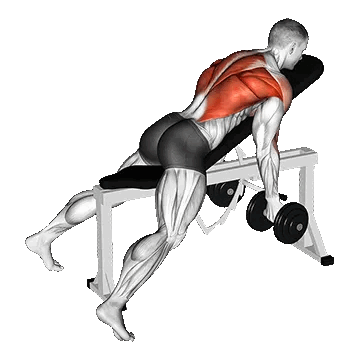
How To Do
- Set an incline bench at 45 degrees.
- Start off lying on an incline bench with a dumbbell in each hand extended out in front of you.
- Squeeze your shoulder blades together and push your elbows up toward the ceiling to bring the dumbbells to your rib cage.
- Please ensure you don’t hyperextend the thoracic spine by pulling your entire upper torso off the bench. You can extend it slightly but don’t make it too drastic.
- Once you reach the final position, hold for a count and squeeze your lat muscles.
- Return to the starting position and repeat for as many reps and sets as desired.
2. Chest Supported Neutral Grip Dumbbell Row
The neutral grip chest-supported dumbbell row is a variation of the chest-supported row and an exercise used to build back muscle and strength.
The back is a muscle group that requires significant variation. So, try different angles and grip positions to maximize back muscle growth.
It would help if you experimented until you find a rowing variation that you like.
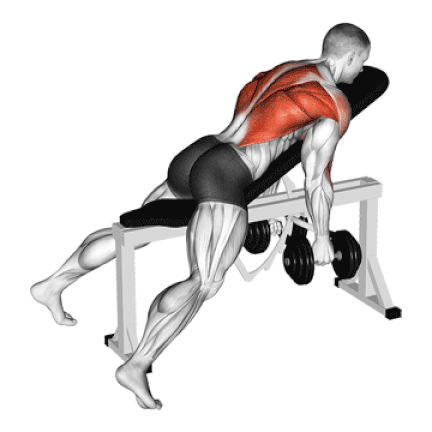
How To Do
- Adjust an adjustable incline bench to a 45-degree angle and lie prone on the bench.
- Grab a dumbbell in each hand with a neutral grip. Don’t allow the head to jut forward as you pull.
- Then, start the movement by driving the elbows behind the body while pulling the shoulder blades.
- Pull the dumbbells towards your body until the elbows are at (or just past) the midline.
- Then, slowly lower the dumbbells back to the starting position under control.
- Keep a controlled motion and avoid jerky movements.
Barbell Chest Supported Row
Barbells are a valuable tool for gaining strength efficiently. Exercise experts also point to several other benefits of barbells.
- Barbells exercises provide versatility, can help you strengthen virtually every muscle in the body with a wider range of resistance.
- The barbell is a very simple tool, so it is easy to learn the basic lifts quickly
1. Barbell Chest Supported Row
The barbell chest-supported row is an effective exercise for targeting the upper back muscles, with added safety benefits for the lower back.
The supported nature of this barbell row variation allows for better isolation of the targeted muscles, including the rhomboids, latissimus dorsi, and trapezius.
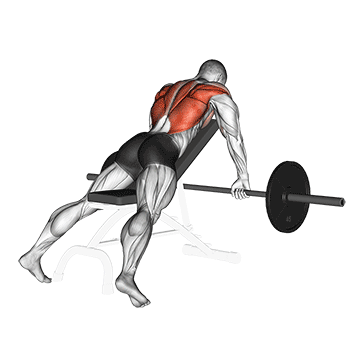
How To Do
- Lie down on an incline bench with a barbell and hand extended out in front of you.
- With a neutral spine and tight core, row the barbell towards your lower rib cage. At the top of the movement, squeeze your shoulder blades together.
- Once you reach the final position, hold for a count and squeeze your lat muscles.
- Return to the starting position and repeat for as many reps and sets as desired.
2. Chest Supported Reverse Grip Barbell Row
The chest-supported reverse grip barbell row is a variation of the barbell chest-supported row that uses a reverse grip (palms facing away from you).
This variation places more emphasis on the biceps brachii and brachialis muscles, while still working the latissimus dorsi, rhomboids, and traps. It also requires the wrists and forearms to work harder to stabilize the bar.
Since the hand position is reverse grip, chest-supported rows can allow you to lift medium weights and achieve a greater contraction of back muscles.
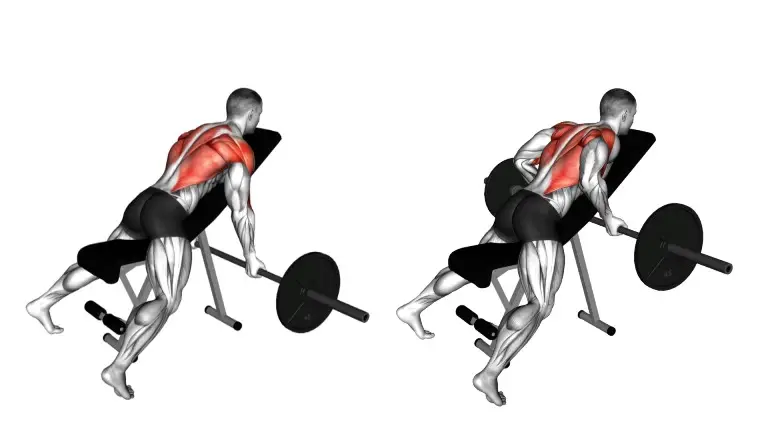
How to Do
- Position an incline bench in front of a barbell.
- Lie face down on the incline bench with your feet grounded firmly. Keep your neck in a neutral position and don’t let your head hang down or look up.
- Reach downward to grip the barbell with a reverse (underhand/supinated) grip.
- Pull the barbell towards your lower ribcage or upper abdomen.
- Make sure you squeeze your shoulders together at the top of the motion.
- Slowly lower the barbell back to its initial position.
3. Barbell Lying Row (Flat Bench Row)
Prone row is performed on a special elevated bench placed on top of boxes or benches. The higher the bench, the greater the range of motion and stretch at the bottom of the movement.
It is usually done as a strength and muscle-building movement in sets of 8-12 reps or more.
The flat bench-supported row is a great alternative to a supported row for two main reasons.
- Because the bench supports you, there is significantly less tension placed on the lower back.
- You can’t cheat with your momentum. It would be best to focus on keeping your front body on the bench; this will eliminate the legs and hips from assisting with the exercise. This will ensure more recruitment from the muscles we try to work in the mid-back and lats.
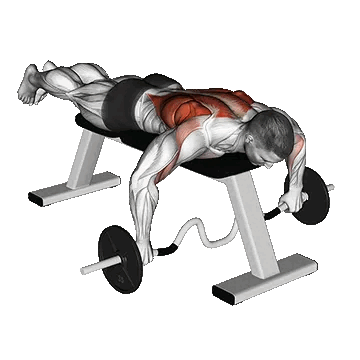
How To Do
- Lie prone on a flat row bench and grab the bar with a grip slightly wider than shoulder width, palms facing toward your feet.
- Pull the barbell toward your upper body until it touches the underside of the bench.
- Then, reverse the movement and go back to the starting position.
- Don’t just swing your arms. Keep controlled motion throughout the exercise.
- Pretend your hands are hooks and pull with your elbows. This prevents the biceps from assisting too much.
Chest Supported Row With Cable
The chest-supported cable row exercises offer an effective way to train the lat muscle. Let’s have a look at some other benefits of exercises with a cable machine.
- Cable-supported rows are a great alternative for people who experience joint discomfort during the barbell row. The cable changes the angle of the movement enough to limit the potential stress on the joints.
- The cable offers great versatility because you can easily change the load, angle, grip position, and body position.
- The cable setup gives your muscles uninterrupted time under tension and a huge pump, both of which can help optimize muscle growth.
1. Chest Supported Cable Row
The chest-supported cable row is performed on a weighted horizontal cable machine with a bench.
The cables are more evenly distributed, and there is a constant load on your back muscles throughout the whole range of motion.
The supported cable row can be performed with different grip position and using different angles and attachments.
- Underhand grip
- Single-arm high row
- Neutral-grip,
- Rope attachment,
- Long bar
- Double arm low row….. Get creative!
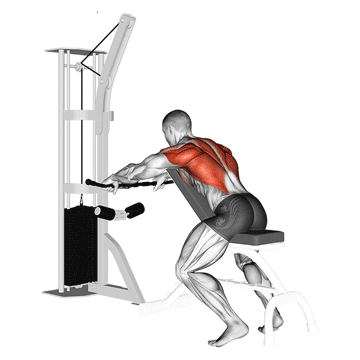
How To Do
- Attach a rope handle to a cable set-up. Alternatively, you can use D-shaped handles on an extended strap.
- Adjust an incline bench to between 30–45 degrees.
- Sit on the bench with your chest against the backrest. Grip the handles and extend your arms.
- Pull your shoulders down and back and brace your core.
- Bend your arms and pull the handles toward your lower ribs. Focus on moving your shoulder blades through the full range of motion.
- Smoothly extend your arms, let your shoulders shrug forward to stretch your upper back, retract your shoulders again, and repeat.
2. Underhand Grip Chest Supported Cable Row
The Underhand grip chest-supported cable row, also known as the seated chest-supported row, is a great movement for shoulder girdle health and for creating balance in horizontal pulling and pushing (especially for frequent bench-pressers).
Maintaining proper form is also a bit easier than in dumbbell, bent-over rows.
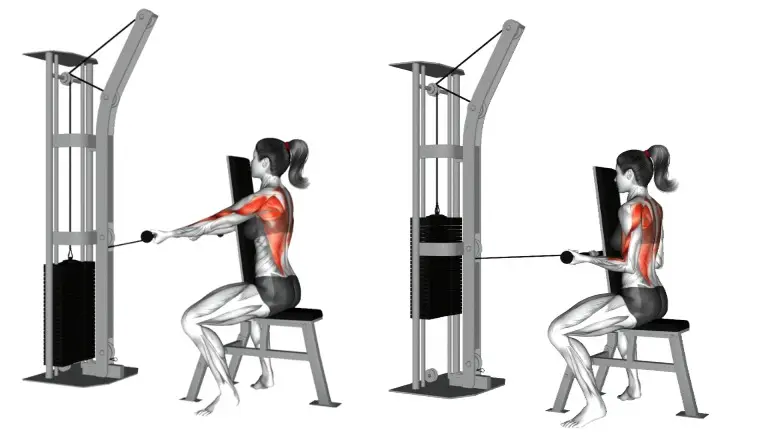
How To Do
- Grip the handle underhand at shoulder width. Brace through the core before beginning the movement.
- Keep your back upright and tight throughout the movement.
- Keep the hips and lumbar spine stationary, and allow only the shoulder blades and arms to move.
- Focus on bringing the shoulder blades together at the end of the range of movement.
- Return to the start position under control, maintaining the same braced position in your torso.
Machine Chest Supported Row
There are many benefits to using machines for back workouts, from safety to output to time efficiency. Here are a few of them.
- Machines move on a fixed path. The handle and lever move from point A to point b and don’t deviate. That reduces the incidence of injury.
- A second benefit is the restraint or support that the machine provides.
- Machines exercises also allow us to control range of motion, specifically where to start, where to end, and what range to work within.
1. Chest Supported Machine Row
Machines are always a good choice if you’re recovering from an injury or just starting out, or perhaps you simply want to maximize muscle hypertrophy. It doesn’t really matter which chest-supported row machine you use; they will all get the job done.
Next, select the handle and grip on the machine based on your preferences.
You will typically be able to use an underhand grip, overhand grip, neutral grip, close grip, and wide grip.
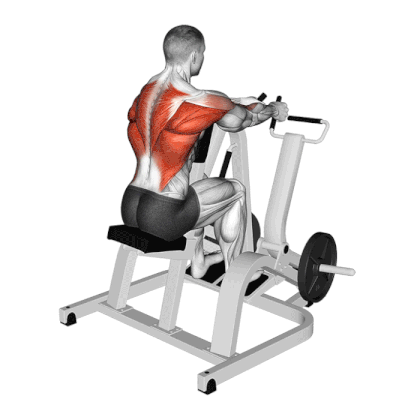
2. Chest Supported T-Bar Row
The chest-supported T-bar row, also known as the chest-supported machine row exercise, is similar to T-bar row and allows you to concentrate on working the vast majority of muscles located in the posterior side of the upper body.
The advantage of this variation is the great stability offered by the machine, allowing you to concentrate on contracting the muscles. A slight disadvantage may be difficulty breathing with heavy loads.
The chest-supported t-bar machine row can be performed with different grip variations, such as an overhand, reverse, or neutral grip.
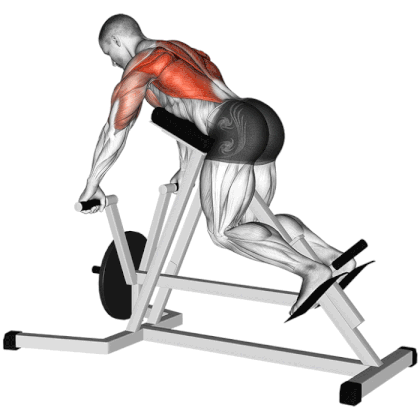
3. Chest Supported Reverse Grip T-Bar Row
The reverse grip T-bar row is a strength training exercise that works the same muscles as rowing a boat. The goal is to strengthen the muscles that move the arms toward the body and the muscles that move the shoulder blades toward the spine.
Because of the hand position, reverse grip t-bar rows can allow you to lift medium weight and achieve a greater contraction of back muscles.
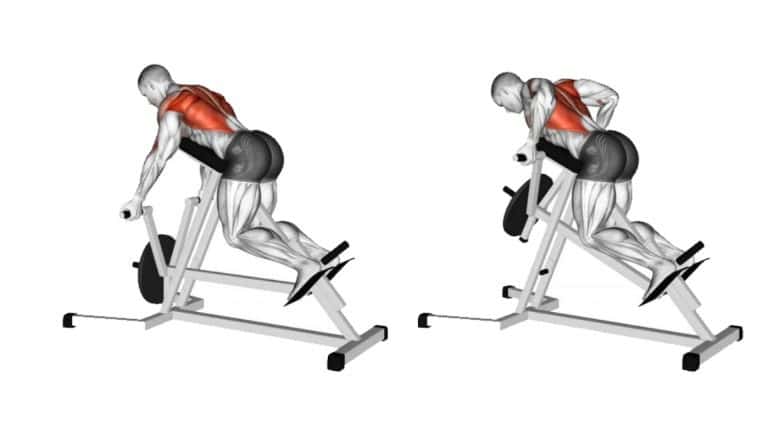
FAQs
is chest supported row a compound movement
Yes, chest-supported rows are a popular type of compound exercise. They involve several joints that move across an extensive range of motion.
As a result, it recruits many muscles from around the upper body, making it an effective exercise for developing upper-body strength and endurance.
Why are chest-supported rows harder
The Chest-Supported row is harder because it keeps your front body strict to the bench, which prevents too much body swing.
Chest supported row vs. bent over row
The bent-over row is a compound movement, whereas the chest-supported row focuses on back isolation. The benefits of the supported row have already been discussed.
The bent-over row is a great muscle builder because we hold the weight on our own, so our core and legs do a lot of stabilizing work.
Chest-supported row vs Cable seated row
The main difference between a seated row and a supported row is that in a seated row, our core and back muscles work to keep us stable while we do a rep.
Does chest support row work biceps?
The Chest supported row is a compound exercise, so it works many different muscles at the same time. The chest-supported row will work your entire back and biceps.
- Primarily muscles worked are the upper and mid-back (Latissimus dorsi, rear delt and trapezius)
- Secondary muscles worked during the chest supported rows are Biceps, brachialis, Brachioradialis
Thanks for reading
Stay Fit, Live a Happy and Healthy Life
References
- Ronai, Peter MS, CSCS, RCEP: Exercise Modifications and Strategies to Enhance Shoulder Function. Strength and Conditioning Journal: August 2005 – Volume 27 – Issue 4 – p 36-45
- Lorenzetti S, Dayer R, Pluss M, List R. Pulling exercises for strength training and rehabilitation: movements and loading conditions. J Funct Morphol Kinesiol. 2017;2(3):33. doi:10.3390/jfmk2030033
- Mazur LJ, Yetman RJ, Risser WL. Weight-training injuries. Common injuries and preventative methods. Sports Med 16: 57–63, 1993.
- Loturco, I., Suchomel, T., Kobal, R., Arruda, A. F. S., Guerriero, A., Pereira, L. A., & Pai, C. N. (2021). Force-velocity relationship in three different variations of prone row exercises. Journal of Strength and Conditioning Research, 35(2), 300-309.
- Signorile, J. F., Zink, A. J., & Szwed, S. P. (2002). A comparative electromyographical investigation of muscle utilization patterns using various hand positions during the lat pull-down. Journal of Strength and Conditioning Research, 16(4), 539-546.
- Andersen, V., & Fimland, M. S. (2014). Effects of grip width on muscle strength and activation in the lat pull-down. The Journal of Strength and Conditioning Research, 28(4), 1135-1142
- Lehman, G. J., Buchan, D. D., Lundy, A., Myers, N., & Nalborczyk, A. (2004). Variations in muscle activation levels during traditional latissimus dorsi weight training exercises: An experimental study. Dynamic Medicine, 3, 4. doi: 10.1186/1476-5918-3-4

Manish is a NASM-certified fitness and nutrition coach with over 10 years of experience in weight lifting and fat loss fitness coaching. He specializes in gym-based training and has a lot of knowledge about exercise, lifting technique, biomechanics, and more.
Through “Fit Life Regime,” he generously shares the insights he’s gained over a decade in the field. His goal is to equip others with the knowledge to start their own fitness journey.
